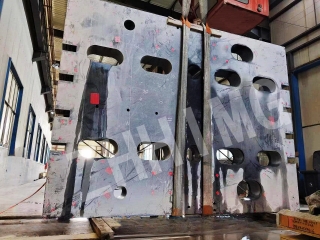Granite is a popular material used in the manufacturing of wafer processing equipment due to its exceptional mechanical and thermal properties. The following paragraphs provide an overview of the advantages and disadvantages of using granite in the wafer processing equipment.
Advantages of Using Granite in Wafer Processing Equipment:
1. High Stability: Granite is a highly stable material that does not warp, shrink, or twist when subjected to high temperature variations. This makes it an ideal material for use in the semiconductor industry, where temperature-sensitive processes are involved.
2. High Thermal Conductivity: Granite has excellent thermal conductivity, which helps maintain a stable temperature during the processing of wafers. The uniformity of temperature throughout the equipment enhances the consistency and quality of the final products.
3. Low Thermal Expansion: The low thermal expansion coefficient of granite reduces the likelihood of thermal stress on the wafer processing equipment, which can cause deformation and failure. The use of granite ensures a high level of accuracy during the processing of wafers, resulting in better yields and lower costs.
4. Low Vibration: Granite has a low vibration frequency, which helps to reduce the likelihood of vibration-induced errors during wafer processing. This improves the accuracy of the equipment, resulting in high-quality products.
5. Wear Resistance: Granite is a highly wear-resistant material, which improves the durability of the equipment and reduces the need for frequent maintenance. This translates to lower costs and consistent performance for an extended period.
Disadvantages of Using Granite in Wafer Processing Equipment:
1. Cost: Granite is a relatively expensive material compared to some alternatives. This may increase the cost of manufacturing wafer processing equipment, making it less affordable for some companies.
2. Weight: Granite is a heavy material, which can make it cumbersome to handle during the manufacturing process or when moving the equipment. This may require specialized equipment or additional labor to transport and install the equipment.
3. Brittle: Granite is a relatively brittle material that can crack and break under certain conditions, such as impact or thermal shock. However, the use of high-quality granite and proper handling reduces this risk.
4. Limited Design Flexibility: Granite is a natural material, which limits the design flexibility of the equipment. It may be challenging to achieve complex shapes or integrate additional features in the equipment, unlike some synthetic alternatives.
Conclusion:
Overall, the use of granite in wafer processing equipment provides several benefits that outweigh the disadvantages. Its high stability, thermal conductivity, low thermal expansion, low vibration, and wear resistance properties have made it a preferred material for the semiconductor industry. Although it may be relatively expensive, its superior performance and durability justify the investment. Proper handling, quality control, and design considerations can mitigate any potential disadvantages, making granite a reliable and long-lasting material for wafer processing equipment.
Post time: Dec-27-2023

